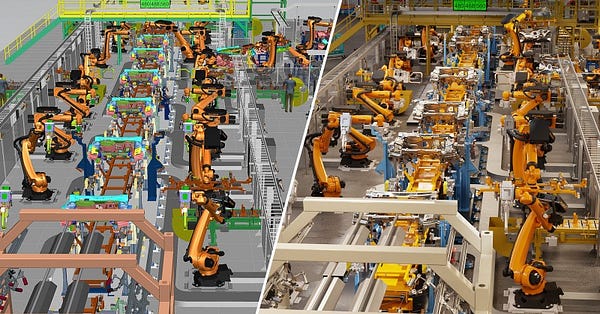A new tech stack for physical industries
New software is increasing the number of viable startups in physical industries
Hi all, in this edition we have:
The launch of a new newsletter for industry news and information on RealTech events, please subscribe! (more info below). I’ll be keeping this newsletter for longer thought pieces!
A look at a rapidly expanding software stack for physical industries
tl;dr: the historically high cost to build v1 products in physical industries is lowering. Driven by an increase in task specific software applications, from simulation / digital twin, ML, design to workflows and process automation
Hard industries sometimes need soft solutions
“The technology industry moves from the easiest value chains to the hardest ones” John Doerr. We’re now seeing this play out, with an increasing number of founders building in physical industries, namely AEC, hardware and Bio. Critically, we’re also seeing an increasing number of founders building software tooling and applications for said industries.
The core initial complexity for companies’ building physical products is the high costs (time and capital) of getting a product to be commercially viable. This is due to comparatively slower development cycles (versus software) given complexities (cost + lead times + volume needs + edge cases) of incremental physical product iterations. However, software is increasingly serving as critical tech infrastructure, creating new applications and modes of company building and lowering the hurdle to profitability.
A new tech stack is being built
There is a new stack being built on top of the shift to cloud. There are three large scale changes happening 1) prevalence of cloud computing 2) cheap sensors everywhere 3) massive increase in GPU compute and ML


This new technology stack includes simulation engines (in silico) and advanced 3D design tools, allowing for the development-build-test-deploy (“DBTD”) cycle to be done more efficiently. Interoperable programs, open standards, and APIs also allow for higher data fidelity, collaboration, and workstreams. Machine learning is a key enabler of this technology stack, driving reductions in the search space optimisation and leading to optimal discoveries and designs across physical domains, such as Bio and AEC. It’s also allowing large improvements in robotics across tasks.
Hardware costs are also decreasing, from sensors to chips. The death of Moore's Law is pushing chip makers to produce workload-specific chips for fields such as biology, energy efficiency, and automotive. There is also a transition from Intel to ARM/Nvidia architectures and open interfaces to edge computing hardware.
Abstractions, at all levels
There is a common refrain that Tesla is 6 companies in 1 (assembly, batteries, software etc.). Tesla's vertically integrated approach, which allows them to build and test quicker than incumbents, has been a structural advantage. However, most founders would rather abstract company components and cost line items away (instead of building their own), especially when capital is scarce. Companies can turn their fixed investments (CAPEX) into variable costs (OPEX), for example AWS allowed founders to rent server capacity instead of building their own.
This is having a number of specific effects on companies such as enabling remote collaboration, improving data integrity and silos, increasing reproducibility of experiments, testing in silico, etc. It significantly lowers the time to market and hurdle to profitability. For example; Uber needed to build their own real-time data streaming on Kafka to provide live data, location and pricing for the app. Companies can now use Quix’s software straight out of the box to do so, allowing you to build applications on top of live telemetry data and obviate the need to hire 20+ engineers. This is now allowing a number of IoT and mobility companies to build similar functionality. Ultimately, the increase in tooling does two things;
Lowers the cost and time to get a product to market
Expands the market of use cases and applications built on this infrastructure
Technological progress is enabling a new stack to be built on top of cloud, this is dramatically lowering the hurdle to getting physical products built and enabling new use cases and applications.
🚨PSA🚨
If you’ve made it this far - please subscribe to a new newsletter bringing you weekly RealTech news and event invites. The newsletter is designed to given you snippets of the most relevant industry news.




